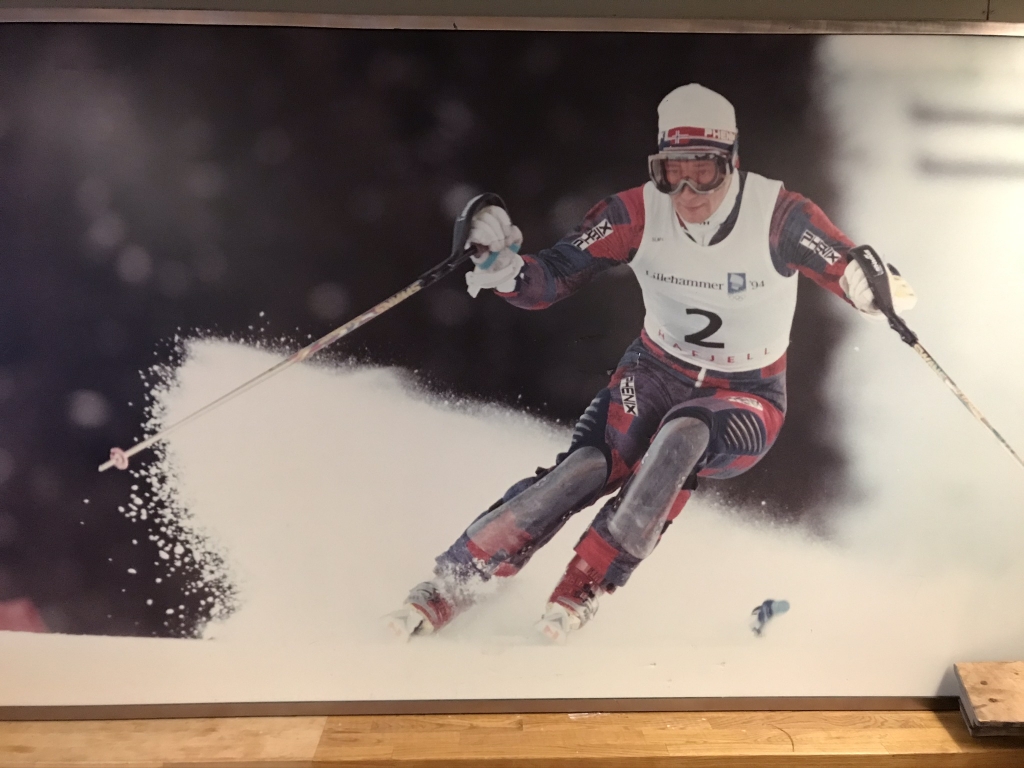As winter descended at the end of 2019, and everyone was blissfully unaware of the calamity that would befall us early next year, I was making plans for where I would be taking my snowboard. I really wanted to go somewhere that had hosted Olympic skiing, if not snowboarding. Two Olympic hosts were at the top of my list: Albertville, France (1992) and Lillehammer, Norway (1994). I was also looking at Torino, Italy (2006) because they actually held snowboarding events that year at the Bardonecchia ski resort; Albertville and Lillehammer only had skiing, since snowboarding didn't become an Olympic sport until 1998.
But, I actually had watched the 1992 and 1994 games on TV, so there was some childhood nostalgia pushing me in that direction. I totally missed 2006 so there was no familiarity there. So I finally decided to go with the two Lillehammer '94 venues, Kvitfjell and Hafjell, and put off Albertville '92 for early spring 2020. You can guess what happened to the last half of that plan.
Initially I wanted to stay on the ground for this whole trip, take a train up to a northern German port city, take an overnight ferry from there to somewhere in Norway or Sweden, enjoy the sunrise over the North Sea, and then trains the rest of the way. This can be done! But after looking at all the train and ferry schedules I couldn't cobble something together that would fit in the six days I took off from work. Begrudgingly, I bought a round trip Eurowings plane ticket from Hamburg to Oslo and back. The rest of the journey would be trains.
Tuesday, December 17, 2019
This day was an ordinary work day, up until the moment I got home. My luggage was already packed, one huge rollaround with my helmet, boots, etc. in it, and next to that was my snowboard. I got home from work with not a lot of time to spare. All I had time to do was pick those things up, put my heavy winter coat on and start walking toward the S-Bahn station.
Unfortunately, I got there just in time to see an S-Bahn leave in the direction of the Stuttgart city center without me! I had to take the next one, and that did get me to the central train station in time, but just barely. I had to run through the sprawling Hauptbahnhof underground S-Bahn complex, dragging my big suitcase with one hand and carrying that snowboard on my shoulder with the other, into the Hauptbahnhof itself, down the long walkway to the train platforms, and finally onto my first train of the day, an EC which I rode to Mannheim. I couldn't find an empty seat, but that was OK, I just sat on the floor in one car, where I could finally relax knowing I didn't have to hurry anymore.
The second train was a high-speed ICE which I rode from Mannheim to Hamburg for over four hours. Between the two of them, the slower Stuttgart-Mannheim EC ride and the ICE to Hamburg, the whole trip from Stuttgart to Hamburg lasted five hours and thirty minutes, and that's counting a 20-minute layover in Mannheim! I find this astonishing now, because in August 2020 a direct trip on an ICE from Hamburg to Stuttgart with no transfers lasted six hours. Remember, a road trip between the two cities would probably last at least nine; it's about the same distance from San Antonio to Oklahoma City.
So when I got to Hamburg, I spent the night in a hostel, a&o Hamburg City. You have to take either the S-Bahn or U-Bahn from the central station to the Berliner Tor station and the hostel is a short walk from there. I was, almost doubtlessly, the only person walking around Hamburg that night carrying a snowboard. I had no time to do or see anything in the city that night, just go to sleep in my top bunk and wake up the next morning to catch a flight.
Wednesday, December 18, 2019
This was my first time staying in an a&o hostel, and I was quite impressed with the breakfast they were serving. It was a buffet with all the stuff I like for breakfast, that is, müsli and fresh fruit. At an a&o it's not complimentary, you have to either buy it with your room reservation or separately at the front desk. You'll get a token, with a specific color for whatever day it is, which you then turn in at the cafeteria.
From there, I had to catch an S-Bahn to Hamburg Airport. That's not a translation of a German name, by the way, the actual official name of the airport, that you see on all the signs, is "Hamburg Airport."
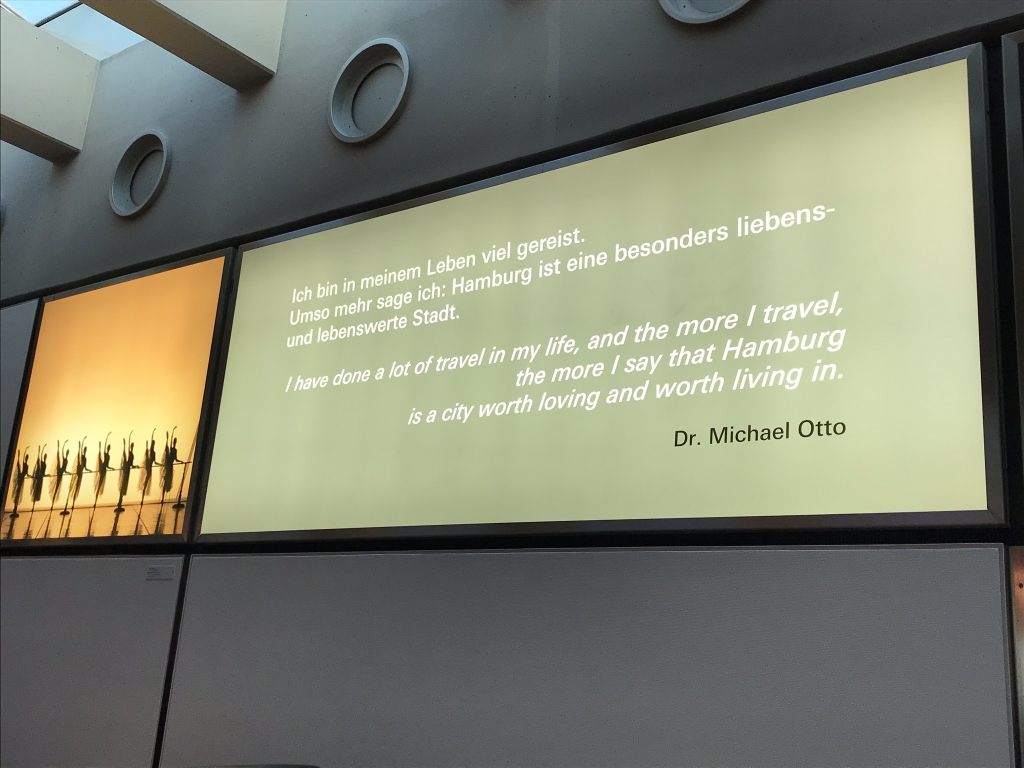
I knew I'd have to come back one day and see the city for myself, and thankfully I did, twice.
The flight from Hamburg to Oslo-Gardarmoen airport covered the most distance of this journey but was only two hours. After getting there, since I was no longer in the Eurozone or even the EU, I had to hit an ATM.
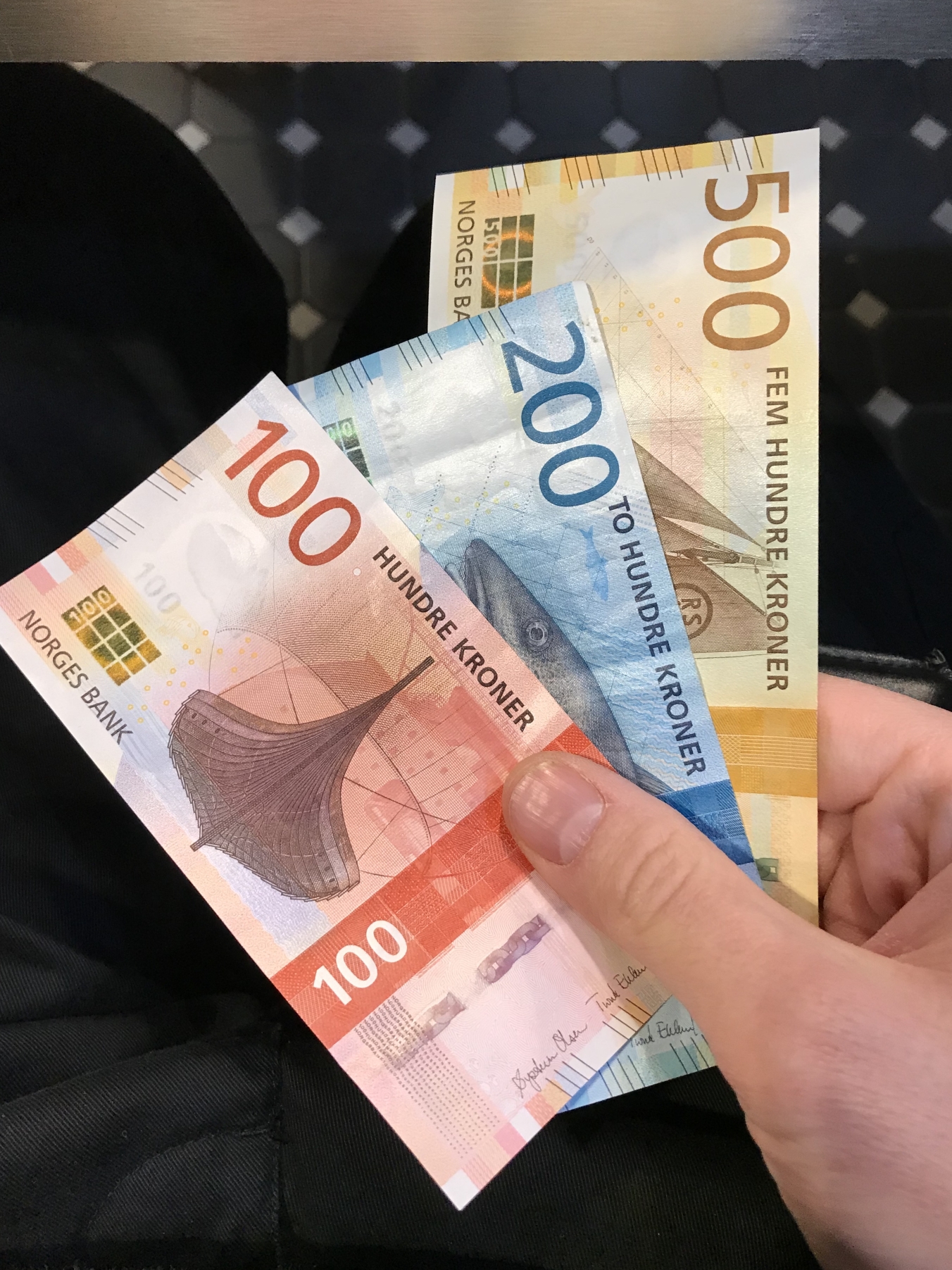
10 NOK are worth about $1.16.
After lunch I then had to find my way to the trains. The rest of this day would be spent on a train journey from Gardarmoen to Kvitfjell, not on a high speed train. I had a hard time earlier figuring out how to get to Kvitfjell, since it's rather isolated, so if you want to go there yourself, here's how.
The closest train stop to Kvitfjell is in a little town called Ringebu. This is where I booked my trip to. And along the way, if you watched the '94 Olympics, you'll hear some familiar town names as certain stops are announced: first Hamar (speed skating, figure skating, hockey), then Lillehammer (the host city), and Hunderfossen (bobsled and luge). Past all this is Ringebu.
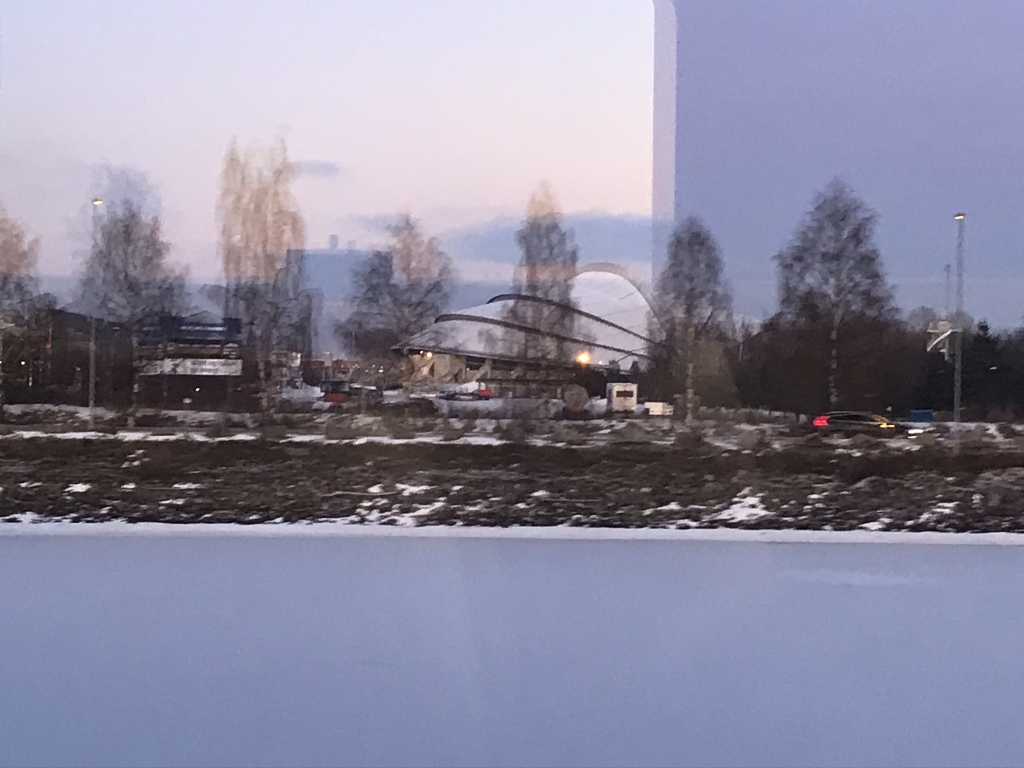
From my train's window I caught a glimpse of Vikingskipet, the Viking Ship, a huge ice arena in Hamar that hosted the long-track speed skating events. Its name comes from its design, in which the roof is shaped like an upside-down Viking longship. This is where Dan Jansen, Bonnie Blair, and Johann Olav Koss earned their gold medals.
The stop for anyone journeying to Kvitfjell is, again, Ringebu. It's little more than a shack which reminded me of certain Amtrak stations back in the US. But then Ringebu isn't exactly a big city. By the time I got here the sun had already set; this was the furthest north I had ever traveled, and in this part of the world, the sun sets between 3:30 and 4 pm in December! At the train station I found a phone number for a taxi company, so I called them and got a taxi to pick me up and drive me to Gudbrandsgard Hotel, which is right there on the mountain at Kvitfjell.
Gudbrandsgard was really a great place to spend a few nights. Being in the location where it was, it really felt like an outpost of civilization in the middle of a wasteland. There was a restuarant there which served a great dinner buffet. There was also a bar there serving a few local specialties. Many of the employees there were seasonal workers from various other countries outside Norway. The bartender that night in fact had lived most of his life in Texas and was rather familiar with San Antonio!
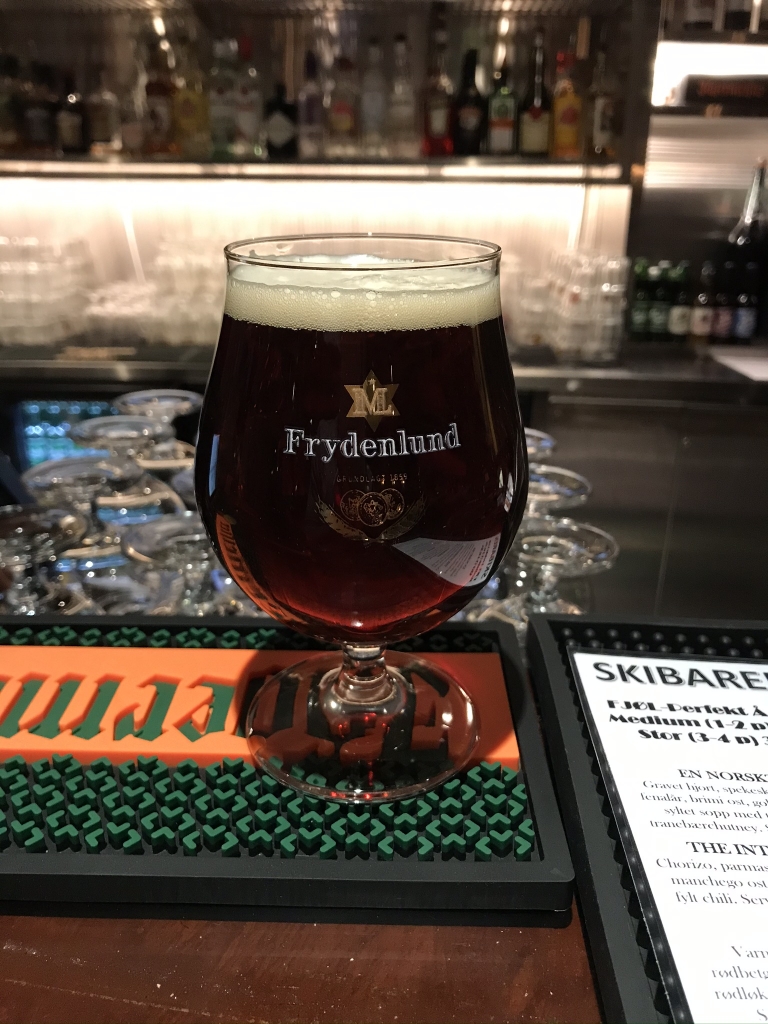
My first beer in any Nordic country. Skol!
Thursday, December 19, 2019
Now it was my first morning in Norway and could finally take my snowboard out on a mountain that had once hosted Olympic skiiing! I bought a two-day lift pass at the booth outside which was my ticket to the slopes for the next two days...
Well, before I went up and down the mountain I took a wrong turn and found myself in the cross-country Nordic skiing area. It took me a little while to figure out where I was and how to get back out. Oops...well if you're into Nordic skiing you can do it at Kvitfjell.
The next thing I have to mention about a Norwegian ski resort is how they combine the North American and Alpine ways of naming and rating the difficulty of the slopes. If you go to a mountain in the US or Canada you'll find easy slopes marked with a green circle, intermediate with a blue square, and difficult with a black diamond. In Alpine countries like Germany, Austria, France, Switzerland, and Italy, it's blue for easy, red for intermediate, and black for difficult, and no associated shapes. Additionally North American slopes have (often silly) names like "Bushwacker" and "Jaybird" and "Big Al's" while Alpine slopes only have numbers. The Norwegian system is a mashup of North America and the Alps: a green circle means "easiest," blue square means easy, red rectangle is intermediate, and black diamond as always is difficult. Slopes have both numbers AND names like "Olympiabakke" and "Vestsideløypa."
Kvitfjell isn't a very big ski resort, at least it didn't feel like it to me after all those massive complexes I'd been through in Austria and Switzerland. Most of the slopes are on opposite sides of one mountain, as well as one side of another one. My hotel was at the mountain base in a small cluster of hotels, restaurants and such called Kvitfjell Mellomstasjon at the furthest east end of the resort. Among the many slopes on this side of the mountain were the two that had been used in the Olympics: Øvre Olympiabakke and Nedre Olympiabakke, numbered 1a and 1b respectively. Unfortunately for me, they were both black diamonds, and at that time I hadn't progressed enough to be able to take on anything with that difficulty rating.
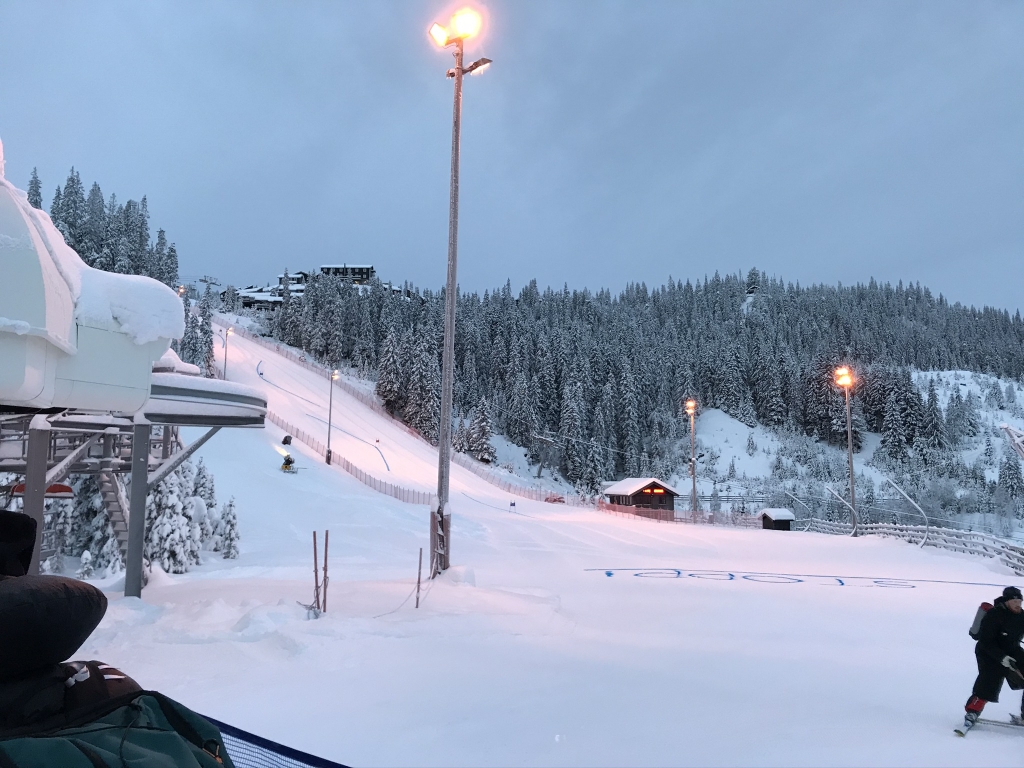
I think this was one of the two Olympic slopes. As you can see, it was being used for a slalom competition that day. Also, this picture was taken at 9:26 in the morning. Like I said before, the sun is not up for very long in December this close to the Arctic Circle.
If you ride one of the lifts to the top of the mountain, you can either go back the way you went up, down one of the slopes on the east side, or go down the other side toward Kvitfjell Vest where more restaurants and a shop await. One of the slopes that leads that way, I think it was 20 (Bjørnliløypa), provided a great view as it passed by several rows of chalets. This and other slopes eventually meet up and pass by a restaurant near the mountain base called Tyrihanstunet.
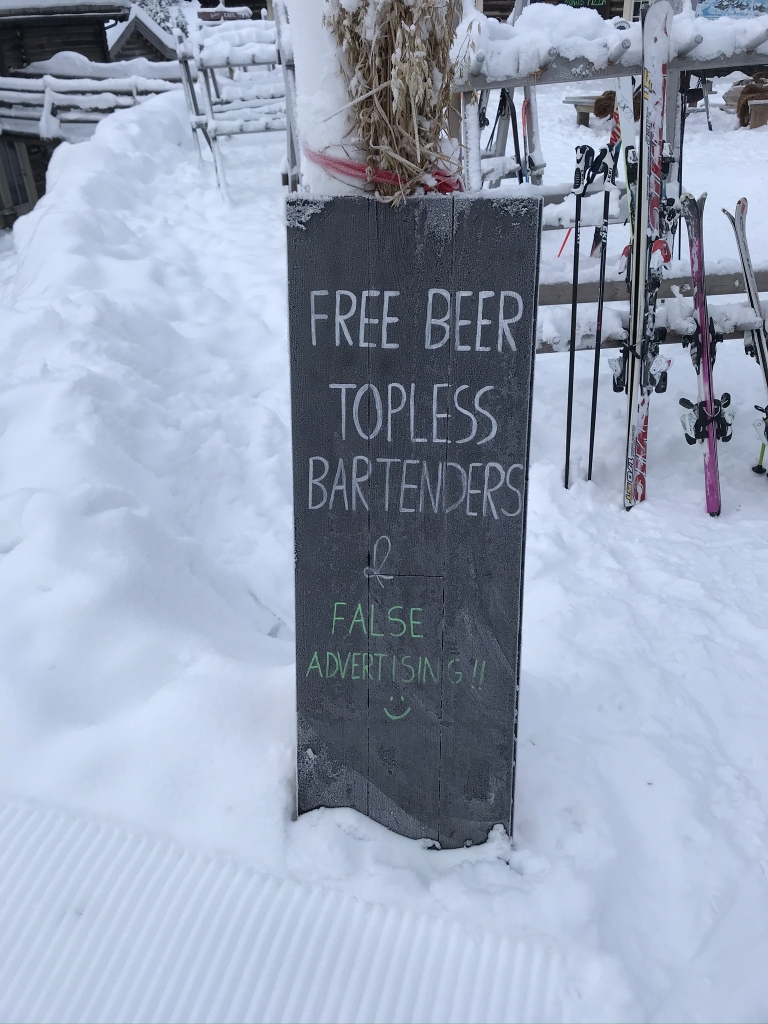
Funny sign outside a restaurant, Tyrihanstunet. I had lunch here at least once.
At the mountain base on that side is Kvitfjell Vest where you'll find a restaurant that serves some delicious hot chocolate, and a cable car that will take you across a valley to another mountain that has a few more slopes on it. I waited until the next day to do both of those things.
Back on the east side, as you're descending the mountain approaching Kvitfjell Mellomstasjon, there's a lively little après-ski bar called Koia.
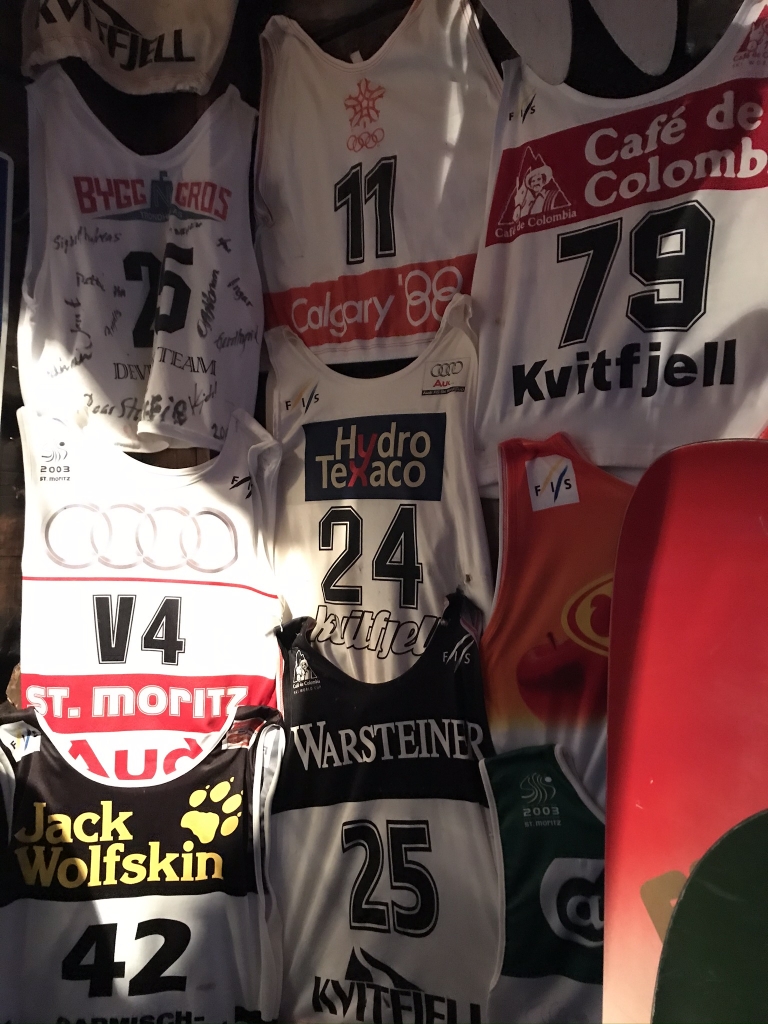
There was a lot of memorabilia like this all over the walls.
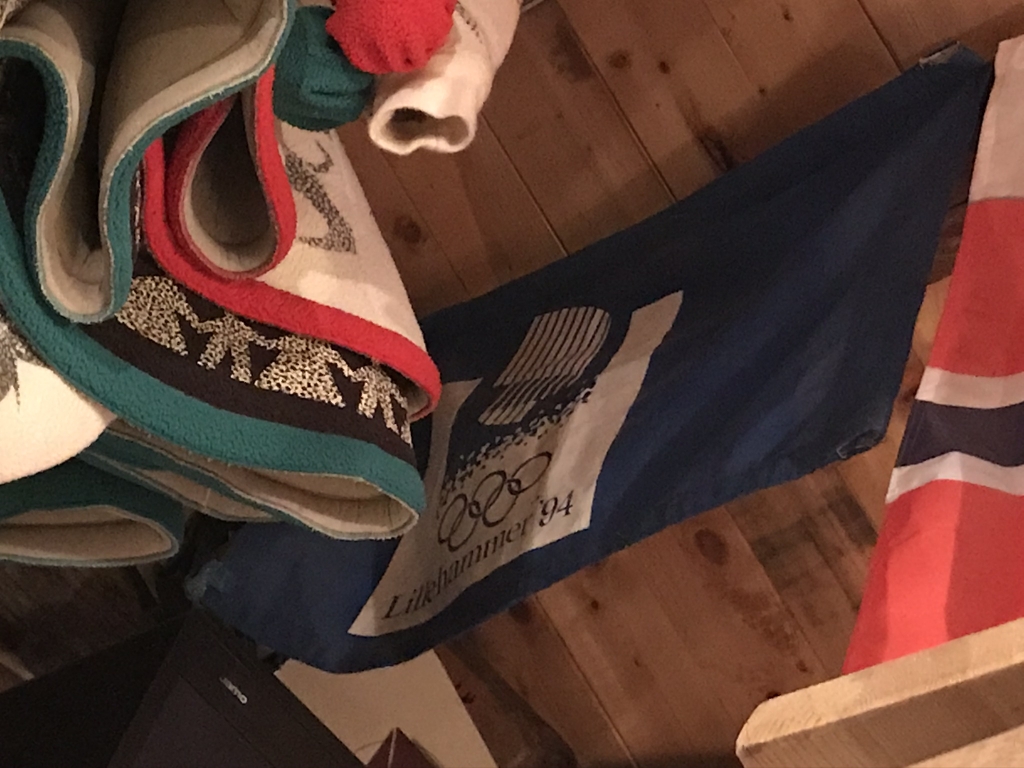
And plenty of flags like this hanging from the ceiling.
One other great thing about Koia: they had two great American beers from Hawaii available in bottles, Kona Longboard lager--which I've drunk on Waikiki Beach in Hawaii--and Kona Big Wave golden ale. I know that American beer has a pretty bad reputation around the world, so it always brings a smile to my face when I see any place outside the US serving good American beer that isn't Bud, Miller, or Coors.
Back at the hotel, there's a bunch of '94 Olympic posters on the wall in one hallway.
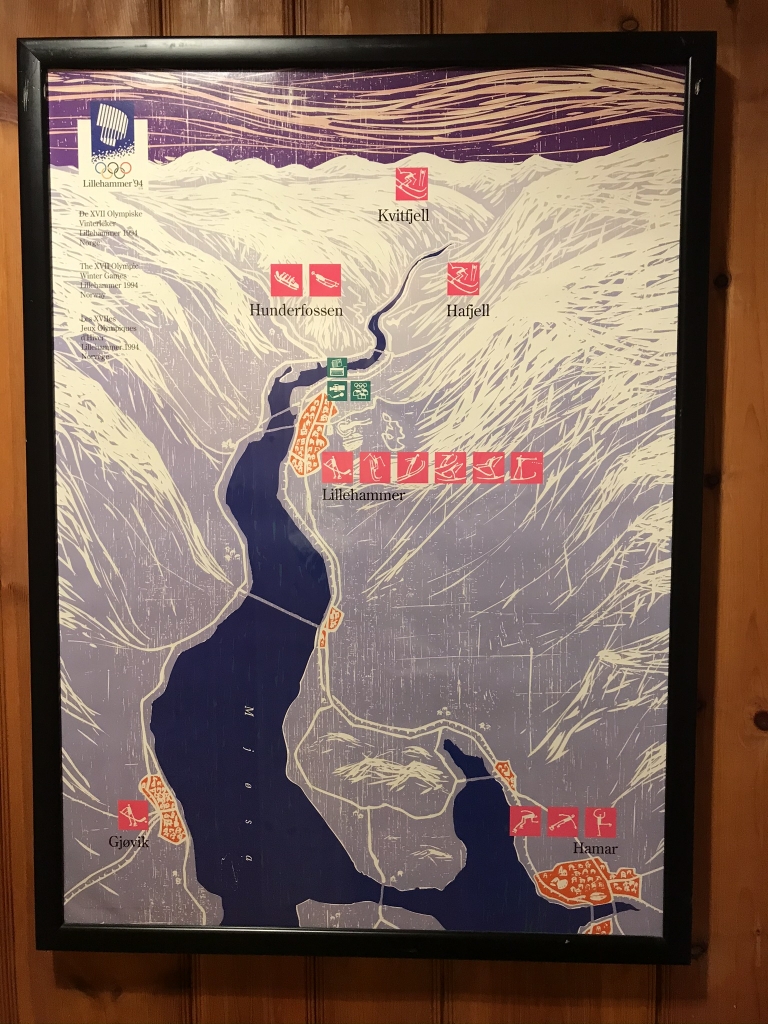
Map of all the venues. Kvitfjell, where we're at, is the furthest north.
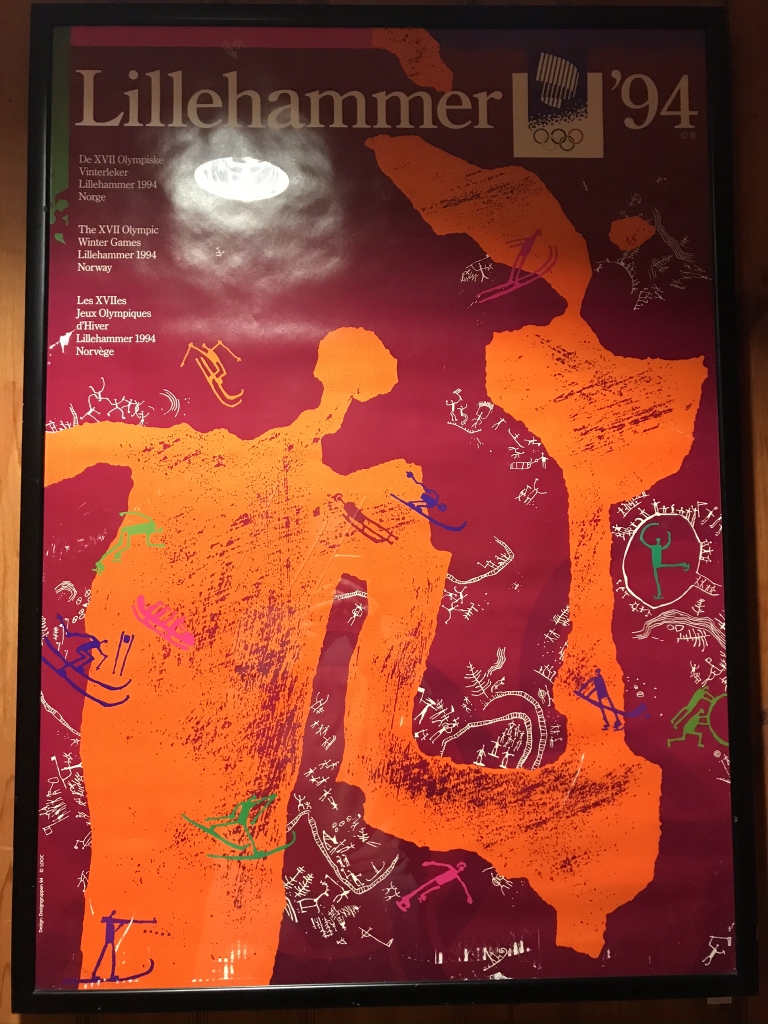
Friday, December 20, 2019
The sun rose around nine in the morning as usual. On this day I couldn't do much snowboarding in the morning because the chairlift outside the hotel was broken. Apparently the weather was just too cold for the machinery, even there at a ski resort, something I'd never seen happen before. Repairmen spent most of the morning fixing it, so it wasn't until 11 or so when I could finally get on the lift.
While waiting in line at the chairlift, there was a youth ski team in front of me doing practice runs. One of them was wearing leggings which were memorable because of the knock-off basketball logos they were covered with. This pair of leggings was supposed to be covered with NBA teams' logos, but they were all hilariously misspelled, for example "DETROIT RISTONS" and "OHOENIX NUNS."
I did a few warm-up runs on the east side and eventually headed west. I mentioned before that there's a restaurant in Kvitfjell Vest that serves hot chocolate and I stopped there for some of that.
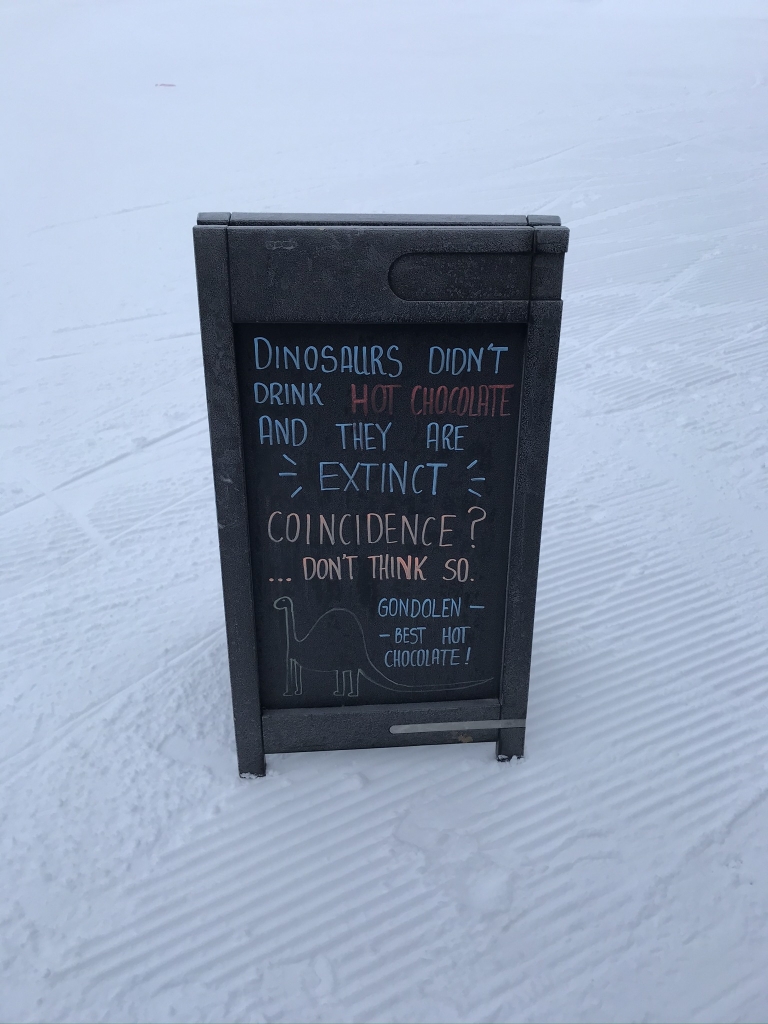
After that delicious hot chocolate I rode the gondola over the valley to the other mountain. This part of the resort was not quite as impressive as the rest of it.
So, there wasn't much more new ground to cover at this point. After I did a couple runs on the other mountain, I took the gondola back, rode down a few more, and since I had a train to catch in a couple hours, made my way in the direction of the mountain base.
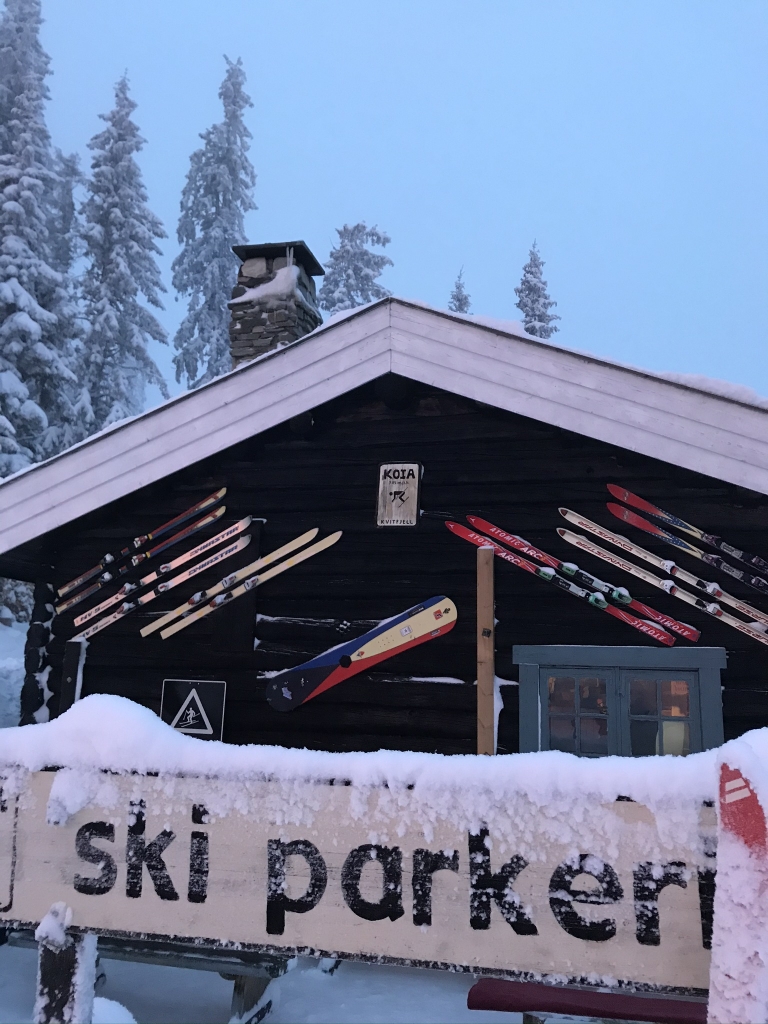
But first, I had to stop at Koia. It's close enough to the mountain base that you can see it from there, but up the slope enough that the only way you can really get there is to ski or ride from above.
Koia was a great little place where I met a lot of interesting people. As the sun set I wished I could stay longer, but I had to leave. I had to get a taxi ride out of there so I could catch my train out of Ringebu. That taxi arrived a bit late but got me to Ringebu with a few minutes to spare before my train to the next part of this adventure showed up...
So, how does one get to Hafjell? Just like Kvitfjell a couple days earlier, it required a little bit of research. My train ticket was for a short trip south from Ringebu to Hunderfossen. I recognized this name, Hunderfossen, from the '94 Olympics; that was where the bobsled and luge events were held. Unlike the first trip up from Oslo two days earlier, this one was on a sleek high-speed train. Strangely, even though it was late night in a pretty remote location, this train was packed and there was no room to sit that I remember. I briefly stowed my snowboard in one of the racks above the seats but had to take it back down because it was dripping water on someone sitting underneath it. (Sorry!) I spent most of this quick hop standing in the bistro car where there were quite a few people standing around the bar.
I stepped off the train at the Hunderfossen station, which was really just a single platform with a few benches and no actual "station" building. Here is where I made a few wrong turns on foot and got a little bit lost. This train platform was in what appeared to be some kind of campground that was closed for the winter. If you've ever been to a public park anywhere in the US near a lake, where there are a bunch of cabins you can rent, and narrow gravel trails winding their way throughout--it reminded me of Canyon Lake between San Antonio and Austin, Texas--it was very much like that. But with the foot of snow blanketing everything, I had no idea where to go from there. I just saw a building with lights in the distance and thought I should head in that direction.
That was the wrong decision. After trudging down a snowy trail, all alone in the dark night, dragging my rollaround suitcase through the snow and carrying my snowboard over one shoulder, I reached the building only to discover there was no one there. I was, it turned out, standing at the gates of Hunderfossen Eventyrpark (Hunderfossen Adventure Park), an amusement park which was naturally closed for the winter. There were some lights on and a few TV screens showing the usual ads in an automated loop, but no actual people around to tell me where to go.
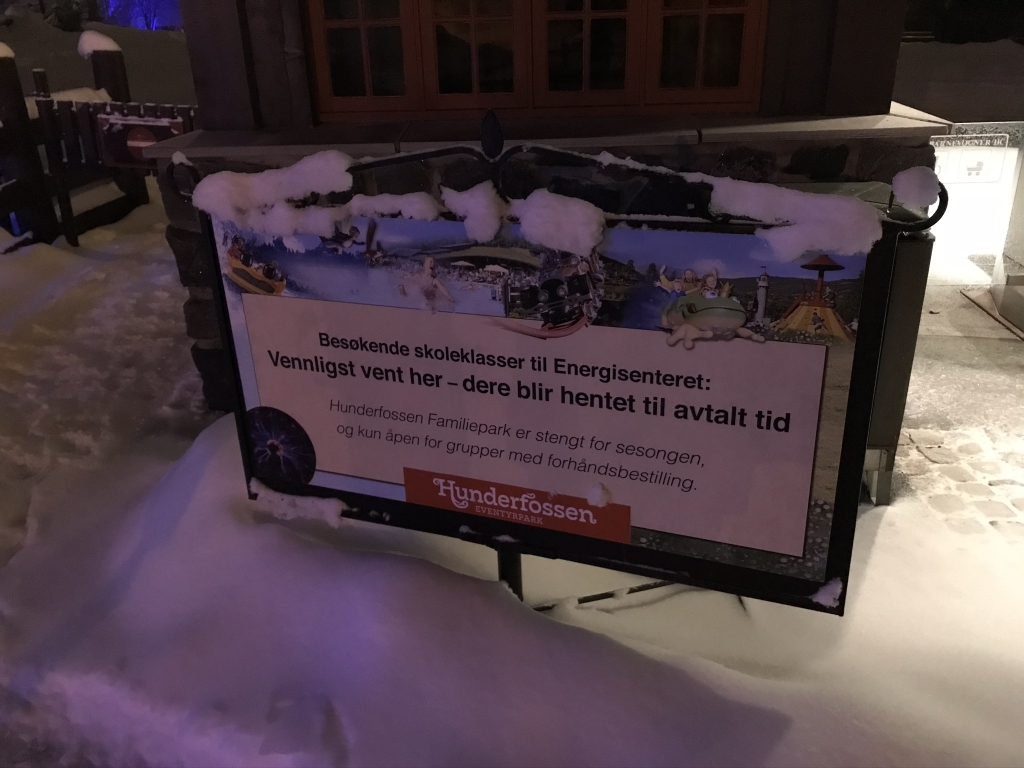
I just ran the lower two lines through Google Translate. It says "Hunderfossen Family Park is closed for the season, and only open to groups with advance booking." Also, the timestamp says it was only 8:19pm when I took this picture. The sun sets so early, and there was absolutely no one around me, it felt like it was after midnight!
After finding a spot with cell reception, I looked up local taxi companies on my phone and managed to get through to one; the first one I called didn't answer. When that taxi finally got there, it wasn't to the spot where I was standing. The cab driver called me and told me that the driveway leading to the park entrance was, of course, blocked by a locked gate, and so I had to walk back down one of the snow-covered trails to the spot where the cab was waiting.
And so, if you want to go to Hafjell: Hunderfossen is the right train stop. But when you step off the train, and you're on the path leading away from the platform, just keep walking straight, because that way you'll eventually reach the main road where there's a bus stop. Don't do what I did, turn right and get lost.
The cab took me to my hotel, Scandic Hafjell. This was a different kind of atmosphere than where I'd stayed last. While my hotel at Kvitfjell was a middle-of-nowhere outpost with nothing outside except another hotel and the ski mountain, this one was in the middle of a small town, Øyer, with a few stores and restaurants within walking distance. The ski resort, Hafjell Alpinsenter, was a short bus ride away from the hotel.
Saturday, December 21 - Sunday, December 22, 2019
Breakfast at the hotel was my usual Müsli and milk, and because this was Norway, some raw fish. I took a bus to the slopes just in time for the mountain to open.
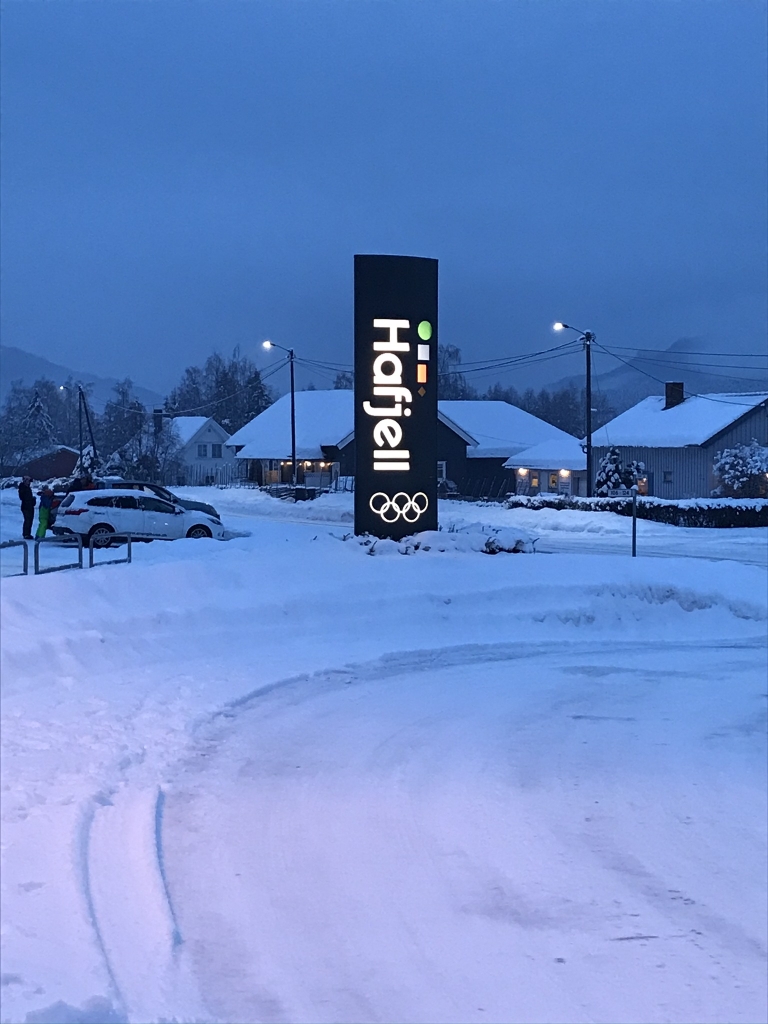
The sign outside the entrance to the ski resort. This was taken at 9:10am. Remember the sun rises late this time of year this far north.
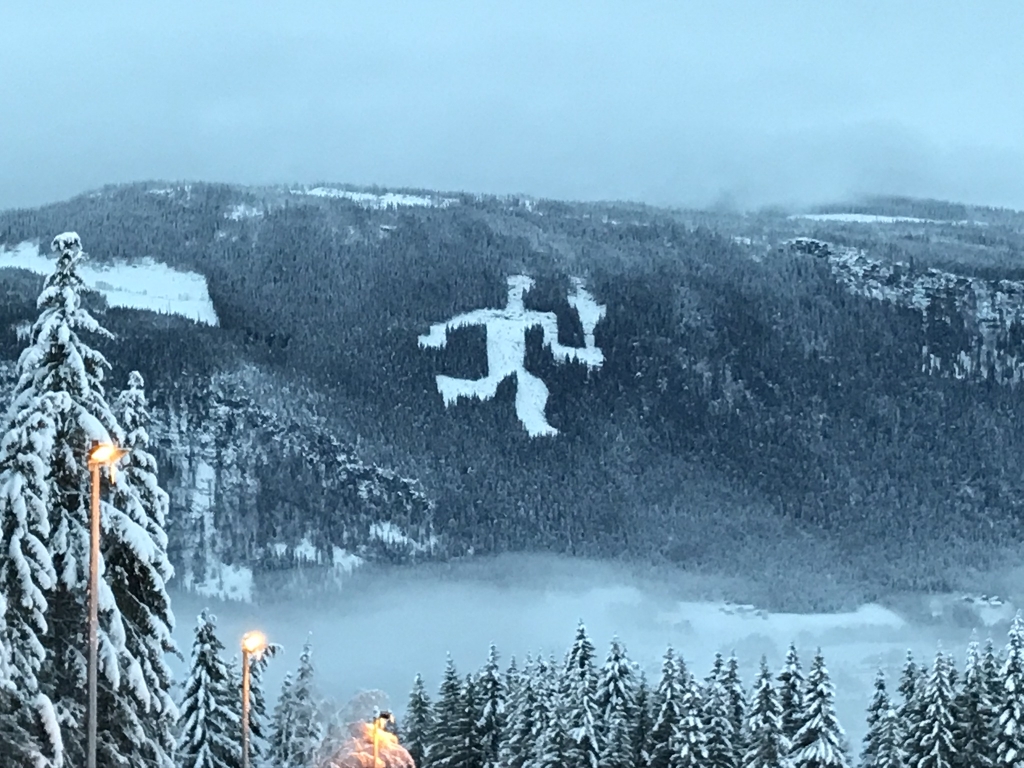
A little further up the mountain--I think this was around the Midstasjonen lift stop--you can see this. It's one of the logos from the Olympics that was put here back in 1994 and maintained ever since.
The slope used for the Olympics is 60, Olympialøypa. Of course it's a black diamond so I couldn't do it then. I might be able to take it on now, though. Maybe I'll be back again someday?
Both of these resorts were my favorites of any ski resort I visited in Europe, even better than those in the Alps. Between the two I think Hafjell was the best. There is a bartender in Kvitfjell's Koia bar who told me that Kvitfjell was better, but while I might find more of that mountain's slopes more memorable, Hafjell was a lot more expansive with more ground to explore. Hafjell has 60 pistes while Kvitfjell only has 38.
Hafjell had some great restaurants on the mountain too. It was while looking at the menu at one of these that I figured out that kylling is Norwegian for "chicken."
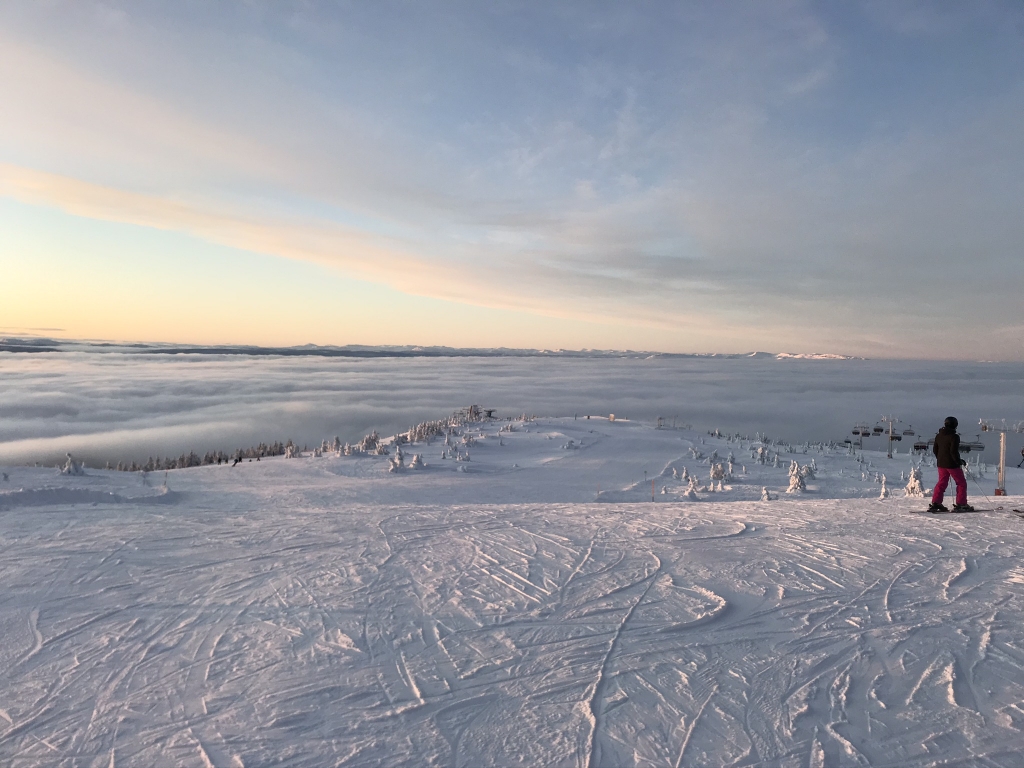
One of the most incredible mountaintop views I've ever seen. This is just below the highest point at Hafjell, on slope 2, Fjelløypa.
After my second day on the slopes at Hafjell, it was time to head home. On both nights I had dinner at an Italian restaurant next to my hotel called Cafe Toscana. After dinner on Sunday I stopped at a nearby grocery store, Spar, to get my usual souvenir groceries like Müsli and coffee, and then had a taxi take me back to the Hunderfossen train station.
Sunday evening's train to Oslo was high-speed, unlike the one I took from Oslo to Ringebu the week before. This journey lasted two hours and 20 minutes. It was mostly uneventful, since it was already dark outside and I couldn't see anything out the window.
I spent that night in a nice upscale-looking but affordable hotel in downtown Oslo, Comfort Hotel Xpress Youngstorget. It was only a short walk from the train station.
Monday, December 23, 2019
The next day was taken up by traveling home, a return flight to Hamburg from Oslo. I have to mention how easy it was to get to Gardarmoen airport from Oslo. Even though this was the international airport serving Oslo, it was quite a few miles away. I've had issues in the past reaching other such out-of-the-way airports, most of them in the US (Washington-Dulles and Houston-Bush come to mind), but there was also that two-hour bus ride from London to Stansted Airport. How do you get to Gardarmoen Airport from downtown Oslo? Ride a dedicated train that runs back and forth between the airport and the central train station. The trip is only 20 minutes!
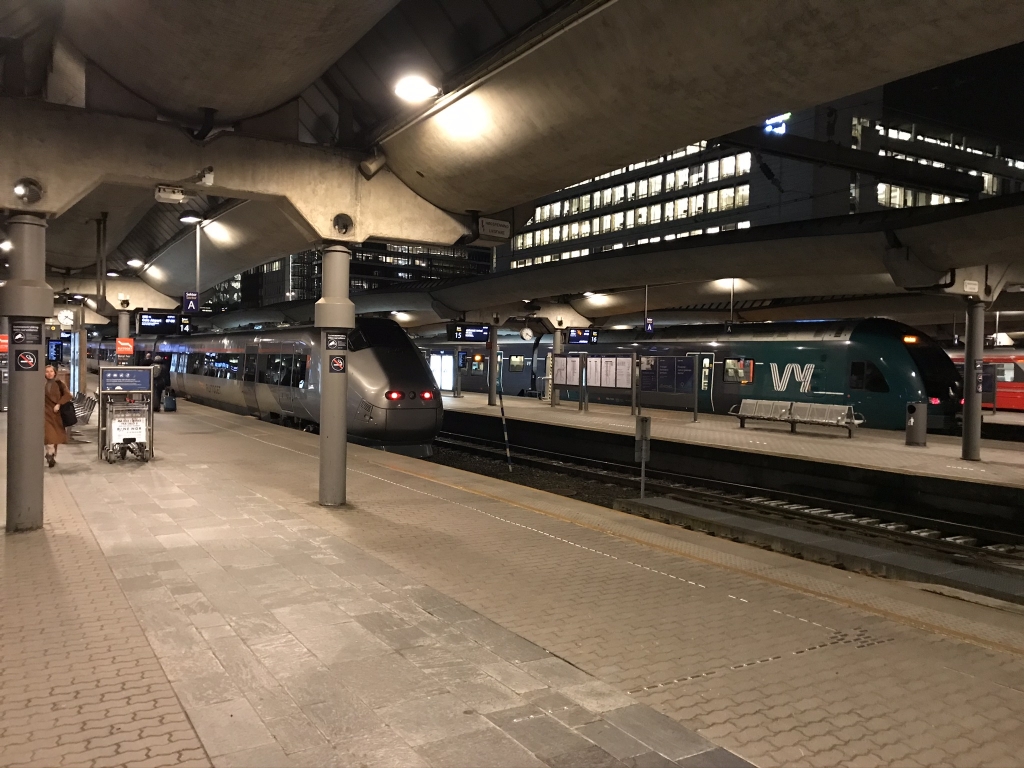
On the left side of this photo is the train, Flytoget, which links Oslo's central train station, where this picture was taken, with Oslo Gardarmoen Airport. It looks just like the high-speed trains in this country.
Speaking of quick trips, after the flight to Hamburg, it only took five and a half hours to get to Stuttgart, including a 20-minute layover in Frankfurt. That's about the same amount of time it took to go the other way a week earlier. Only the first leg of that was on a high-speed ICE; the second was on a slower IC. Interesting how a direct trip on a single ICE takes longer.
So that was my first trip to any Olympic skiing venues. Later in February, I did go to another one, Garmisch Classic in Bavaria, which hosted the skiing in 1936. I also had plans to visit Val-d'Isère and Tignes, France from the Albertville-hosted 1992 Olympics, as well as Patscherkofel near Innsbruck, Austria (1964 and 1976). I even had a hotel room booked for France in April! Obviously a certain disease outbreak put an end to all those plans. And now with me back in the US and no more European snowboarding trips possible for the time being, the next stop on my Olympic journey will probably be Salt Lake City.
